Amatitlania myrnae
Cryptoheros myrnae is named after the Costa Rican ichthyologist Myrna Isabel López Sánchez, director of the Zoological Museum in San Jose. In 1986 she assisted the American Cichlid Association ACA on a catching trip in Costa Rica. Also included was Paul Loiselle, who obtained the type material of this fish on this trip.
Description
Amatitlania myrnae is a small, Central American cichlid that breeds in burrows or otherwise sheltered places. In contrast to most other cichlids from Central America, it is the females here that form a territory during the mating season. Here they court passing men (in the same manner as the men of the rest of the generations). During the courtship period, these females display distinctly different bridal plumage from males. We call this “sexual dimorphism”. More precisely, “reverse sexual dimorphism” because it is the females with the most striking colors.
During the mating season, females develop a trapezoidal dark zone on a predominantly sky-blue abdomen, surmounted by a horizontal golden-yellow band of gill covers to the dark spot in the middle of the body and sometimes further. This lateral spot increases in intensity while at the same time, the intensity of the caudal peduncle decreases. The chromatophores of the double gold-lined dorsal fin spot are now also fully open. The males hardly change during this period.
Amatitlania myrnae is not the only Cichlid with reverse sexual dimorphism. This form of courtship has also been observed in other members of the genus Amatitlania, such as Amatitlania nigrofasciata, Amatitlania septemfasciata and Amatitlania nanolutea, and in Africa it is known among others within the genera Pelvicachromis and nanochromis.
Much is still unclear, for example, “what drove the evolution of reversed sexual dimorphism”. Competition between females? Limited breeding opportunities? Polygamy of men? We do not know. The question of why reverse sexual dimorphism does not lead to an inverted role pattern in brood care, or in the reverse order (as you would expect) remains unanswered. Females of Amatitlania myrnae raise their offspring in the same way as other Central American cichlids.
After spawning, the appearance of the female changes dramatically. All red and yellow shades disappear from the body. This also largely applies to the blue. The melanophores in the dorsal fin and caudal peduncle contract, while the melanophores in the nose, throat, and abdomen and those of the lateral spot open further. The result of this makeover is a silvery-grey fish with a black nose, throat, and belly region. She will herd her young in this conformation for the next few weeks. And she does this with gusto.
Few female cichlids are as fanatical as Cryptoheros females. Even in crowded aquariums, they often manage to raise young and not just their own. In nature, three out of four Amatitlania myrnae nests are found to contain young from other Cichlid species (Michael Tobler 2007). Another notable in-situ observation by the latter researcher is that most Amatitlania myrnae females raise their young alone, in contrast to aquarium observations in which the males apparently cannot evade their parental duties and are often even more fanatical than the females.
Origin
Panama, Costa Rica.
Distribution
According to the existing literature, the fish occurs in only a few rivers of Costa Rica and Panama that flow into the Atlantic Ocean, namely from the Rio Estrella in Costa Rica (Fromm 1988) to the Rio Guarumo in Panama, where the baton is taken over by Cryptoheros nanoluteus (Bussing 1998). Here they occur between 40 and 150 meters above sea level.
However, Michael Tobler did not find the fish in the Rio Estrella in his 2007 survey. However, the fish certainly occurs in the Rio Sixaola basin. In 2002 Michael captured fifteen specimens for his research in the Rio Uatsi (one of the entrances to the Sixaola) and transported them to Europe. The Rio Sixaola is considered a transition zone between the Costa Rican (San Juan) Ichthyofauna and the Panamanian (Istmica) Ichthyofauna and contains several endemic species.

Behavior
The temperament of this fish does not keep up with the size. The fish are much spicier than you would expect. Especially during the mating season, the character of these dwarfs can be called enormous and they often manage to raise young even in overcrowded tanks.
Diet
Omnivore that in nature feeds, among other things, on detritus of plant origin (Bussing 1998). This should be taken into account when caring for the aquarium.
Breeding Amatitlania myrnae
Juan Artigas says “Amatitlania Myrnae breeds in the spring before the rainy season starts. I witnessed breeding activities in March and April in the tributaries of the Rio Sixaola. Females chose a sheltered nesting site between rocks or wood and showed themselves to males, exhibiting their colorful body parts, which intensified during this time.
Pairs were formed and the colour changed to a bright black and white pattern. Flocks guarded their swarm of babies (which don’t exceed 100 in my estimation) once they swam free. Females closely guarded their young, leading them with spastic movements of opening and closing the fins. Males guarded the space around it.
Juveniles were fed by the female (probably also, but less frequently by males) who used the pectoral fins to turn the soil on which the young fed. The cubs were apparently kept under surveillance for several weeks because I saw babies as small as 1.5 cm and still in the care of the parents.” Thus, Juan Miquel Artigas Azas.
The Aquarium
Similar to Amatitlania septemfasciata.
The habitats of Amatitlania myrnae are the shallow areas of rivers and streams with medium to fast-flowing water with sandy silt or leaf bottom. Shelter in the form of rocks or driftwood, but with few plants. Water is clear, alkaline, and hard. Temperature between 24 and 26 Celsius. Occurs together with Amatitlania nigrofasciata and Cribroheros bussingi. This fish is easy to keep in an aquarium from 120 centimeters that take into account its natural habitat.

The water in which Amatitlania myrnae naturally occurs is in all cases oxygen-rich. The fish are found within a temperature range between 21 and 27 degrees. Juan Artigas even mentions a site with a water temperature of 20 degrees. This means not too many fish in combination with good filtration and regular water changes. We also have to keep an eye on the maximum temperature in this regard. The fish are found within a temperature range between 21 and 27 degrees Celsis. Juan Artigas even mentions a site with a water temperature of 20 degrees. I would therefore not maintain too high temperatures for the aquarium. Certainly not above 26 Celsius. The water in which they occur can also be called soft by Central American standards. Until 9 dgh. with a pH range between 5.5 and 8.
Considering the foregoing, Amatitlania myrnae is not a difficult aquarium fish. The small size allows housing in aquariums from one meter. Juan Artigas tells on his site about successfully keeping a colony of Amatitlania septemfasciata in a 120-centimeter tank for many years. This tank accommodated 25 fish of various sizes and four territories. Whenever a male belonging to one of these territories died, he was succeeded by the next in the hierarchy. Juan also says that these are the absolute minimum conditions for keeping these fish. Under current European standards, an aquarium of approximately 160 centimeters would be recommended for the aforementioned setup.
Amatitlania myrnae keeps well with other Central American fish. Combinations with small species such as Thorichthys and larger species such as Astateros do not cause any problems. Less suitable are combinations with other Amatitlania. This is due to the risk of hybridization.
Video
Author
Rene Beerlink – NVC
Copyright images
AquaMojo
Matthijs Meindertsma
Literature
Bussing W. A. 2002. Freshwater Fishes of Costa Rica. Blz 340-342.
Reference
Loiselle P. 1997. “Diagnoses of two new cichlids from the Rio Sixaola Drainage, Costa Rica”. Buntbarsche Bulletin. (n. 180); p 1-8. Previously, this fish was considered a variant of C. septemfasciatus and was known as Cryptoheros (Archocentrus) septemfasciatus “Topaz”. C. myrnae is distinguished from C. septemfasciatus by, (1) the presence of parallel rows of yellow dots on the scales of the lower half of the body. (2) The dim visibility or absence of vertical bands. (3) The presence of small iridescent blue dots in the soft rays of the dorsal fin and caudal fin. (4) In the females (in the mating season) presence of a trapezoidal dark abdominal zone, running obliquely upwards from the beginning of the pelvic fins, to one scale row above the pectoral fins. From there backwards to the lower part of the mid-lateral spot and then diagonally down again to just above the beginning of the anal fin. According to Loiselle P. 1997.
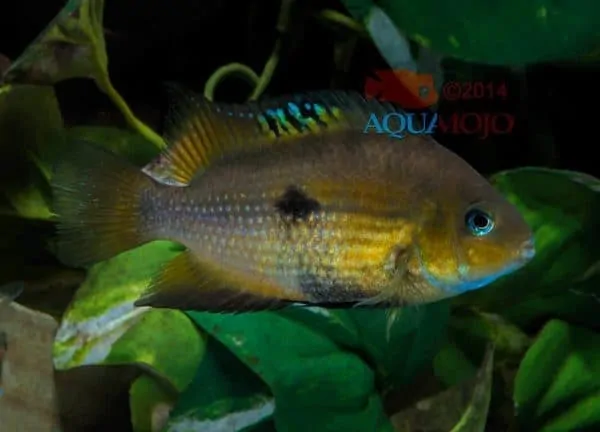








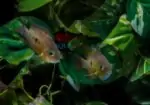
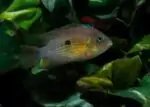

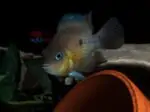
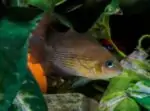
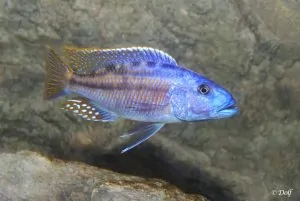



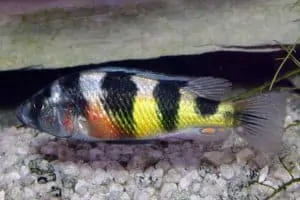
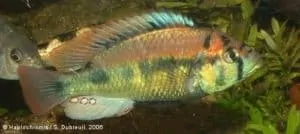

Reviews
There are no reviews yet.